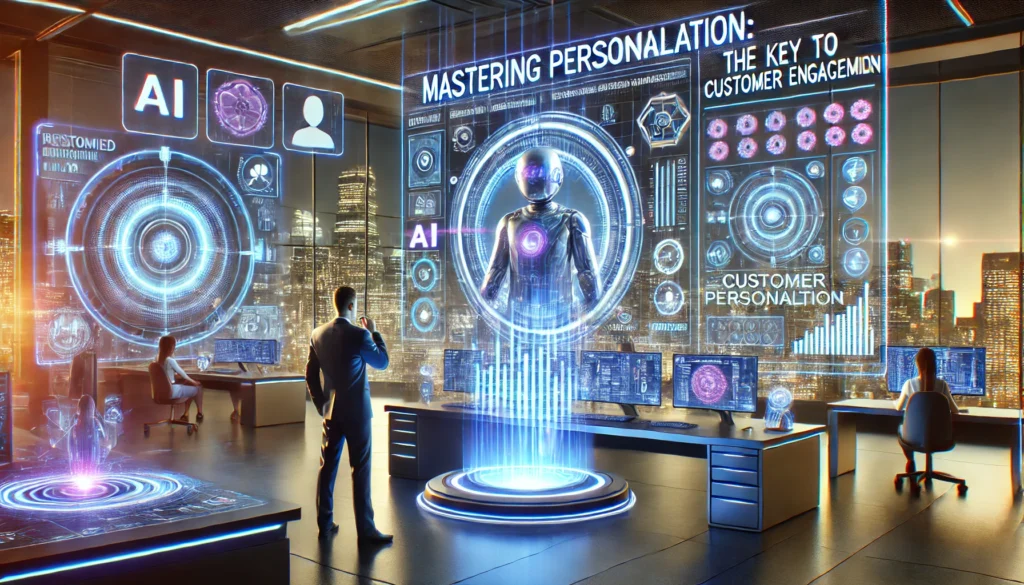Introduction
Imagine walking into your favorite coffee shop, and before you even place an order, the barista greets you by name and starts preparing your usual drink. Feels good, right? That’s personalization in action—a small touch that makes a big impact on customer engagement.
In today’s digital world, where consumers are bombarded with countless marketing messages, personalization is no longer a luxury—it’s a necessity. Businesses that master personalization build stronger relationships, enhance customer loyalty, and drive higher conversions. But how do you get it right? Let’s dive into the world of personalization and uncover how it can transform your customer engagement strategy.
Why Personalization Matters
Consumers today expect brands to know them. According to a study by McKinsey, 76% of consumers are more likely to purchase from brands that personalize their experiences. Personalization creates relevance, making customers feel valued rather than just another name on a mailing list. Here’s why it’s crucial:
- Boosts Customer Loyalty – When customers receive content tailored to their interests, they’re more likely to stick with your brand.
- Enhances User Experience – Personalized interactions make navigation, recommendations, and shopping seamless and enjoyable.
- Increases Engagement and Conversions – Personalization cuts through the noise, delivering the right message to the right person at the right time.
- Strengthens Emotional Connections – People want to feel seen and understood. Personalization builds trust and a deeper relationship with the brand.
Levels of Personalization: Going Beyond First Names
Personalization isn’t just about adding a customer’s name to an email. There are different levels, and the more advanced you get, the more impactful your strategy becomes.
1. Basic Personalization
This includes using first names in emails, acknowledging past interactions, and sending birthday or anniversary discounts. While effective, it’s just scratching the surface.
2. Behavior-Based Personalization
By analyzing customer behavior—like browsing history, past purchases, and engagement patterns—businesses can tailor recommendations, emails, and even website experiences to match user preferences.
3. Predictive Personalization
Using AI and machine learning, brands can anticipate customer needs before they even express them. Think of how Netflix suggests shows you didn’t know you wanted to watch, or how Amazon recommends products you’ll likely buy next.
4. Hyper-Personalization
This is the gold standard. It combines real-time data, AI, and automation to deliver deeply individualized experiences. Imagine walking into a physical store and having the staff know exactly what you’re looking for based on your online activity. That’s where we’re headed.
How to Implement a Winning Personalization Strategy
Knowing the levels of personalization is one thing—implementing them effectively is another. Here’s how you can build a powerful personalization strategy:
1. Collect and Use Data Responsibly
Data is the foundation of personalization. But customers won’t share their information unless they trust you. Be transparent about data collection and use it ethically. Offer something valuable in return, like a discount or personalized recommendations.
2. Segment Your Audience
Not all customers are the same. Use segmentation to divide your audience based on demographics, behavior, purchase history, or preferences. This allows you to create targeted campaigns that resonate with different customer groups.
3. Leverage AI and Automation
Gone are the days of manually personalizing content. AI-powered tools can analyze vast amounts of data to create dynamic content tailored to each user in real-time. Email marketing platforms, chatbots, and recommendation engines all play a role in personalization.
4. Optimize Website and App Experiences
Your website or app should adapt based on user preferences. Show personalized product recommendations, offer dynamic pricing, or customize homepage layouts depending on the user’s past behavior.
5. Engage Through Multiple Channels
Customers interact with brands through multiple touchpoints—email, social media, SMS, and even in-store. Ensure personalization is seamless across all channels. If a customer abandons their cart on your website, send a personalized follow-up email or push notification with a discount.
6. Test, Analyze, and Improve
What works today may not work tomorrow. Continuously test different personalization strategies, analyze customer feedback and behavior, and refine your approach accordingly.
Real-World Examples of Personalization Done Right
Let’s look at some brands that have nailed personalization:
Spotify’s Wrapped
Every year, Spotify provides users with a personalized breakdown of their listening habits, including top songs, artists, and genres. It’s highly shareable, making it a marketing win while deepening user engagement.
Amazon’s Recommendation Engine
Amazon’s ability to suggest relevant products based on browsing and purchasing history is a prime example of predictive personalization. This keeps customers engaged and increases sales.
Sephora’s Beauty Profile
Sephora collects customer preferences and purchase history to offer tailored product recommendations and beauty tips. They even use AI to match users with the right foundation shade through their Virtual Artist tool.
The Future of Personalization
As technology evolves, personalization will only become more advanced. Here are some trends shaping the future:
- AI-Powered Virtual Assistants – Think of AI that knows your preferences better than you do, helping you shop, plan trips, or even curate content.
- Voice and Chat Personalization – Smart assistants like Alexa and Siri are becoming more personalized, adapting to user habits and speech patterns.
- Real-Time Personalization – As 5G and edge computing grow, brands will be able to deliver real-time, hyper-personalized experiences instantly.
- Ethical Personalization – With growing concerns over data privacy, businesses will need to balance personalization with transparency and user control.
Conclusion
Mastering personalization isn’t about bombarding customers with generic messages—it’s about understanding their needs, preferences, and behaviors to create meaningful interactions. When done right, personalization drives engagement, builds brand loyalty, and ultimately boosts revenue.
So, how will you leverage personalization to create better customer experiences? The brands that get it right today will be the ones that thrive tomorrow. Let’s make every interaction count!

